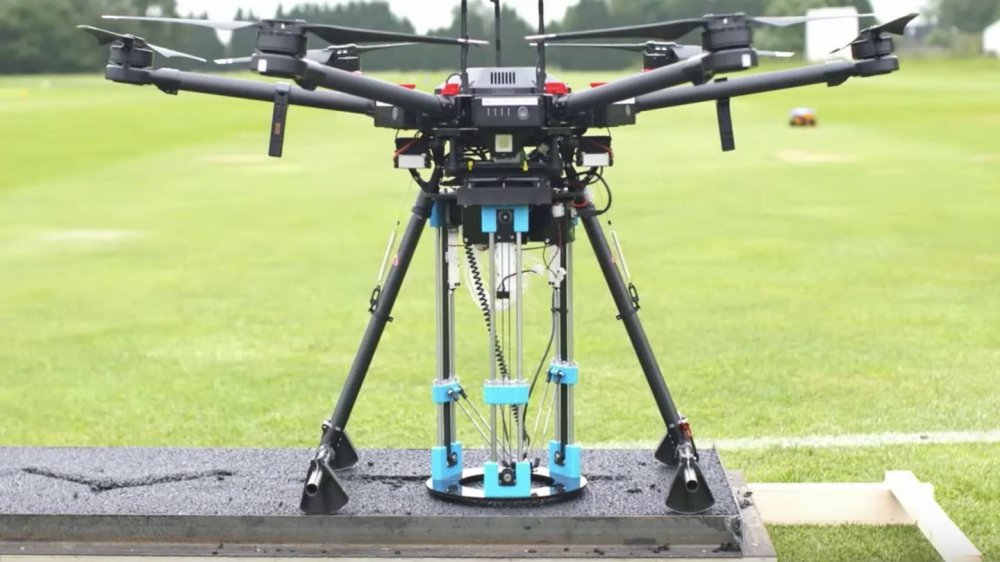As drones become increasingly autonomous, researchers and engineers are finding new ways to let unmanned aerial vehicles manage menial tasks that are usually relegated to crews of workers and valuable time being lost in the process. For researchers at the University of Leeds and University College London, the focus is on slowly but surely kickstarting drone-infused smart-cities with UAVs that could repair roads efficiently, saving time, cost, and the efforts of manual labour.
The six-rotor hybrid aerial-ground UAV whirs above roads while aerially scanning for potential repairmen opportunities using its onboard camera. If a pothole is detected, the drone lands above, making sure the mounted asphalt extruder is directly atop the crevice in need of filling, and releases material such as asphalt with one-millimeter accuracy. On top of that, the prototype not only repairs roads and leaves potholes smoothed over, but improves on the surrounding asphalt, as well.
“This actually disperses other chemicals into the road around it, which helps it rejuvenate itself,” said Jake Smith, Ph.D. student at the University of Leeds. “It kind of helps roads last even longer than they already did. The bigger picture is all about smart cities controlled by developed robots that can intertwine with the city and actually help out with current tasks.”
Smith adds that road repairs are a gigantic hassle for those tasked to fix them and for everybody who has to find detours to bypass the closed down streets. When drone technology becomes so sophisticated and affordable that we, as a society, can reconfigure how to approach these everyday issues with autonomous tech, it’d seem like a waste not to pay attention.
“So we had the idea that you basically close down a road for maybe a couple of hours, our drone flies in, it’ll scan any potholes and kind of get the orientation of the indent, and then once they’ve got the information they then use an extruder to pour repair material,” said Smith. “So asphalt, or tar, or any of that, into the hole and you get a nice, smooth, repaired surface.”
The concept is part of a larger, multi-university project looking at the possibility of self-repairing cities, and how robotics and other automated systems could be used to aid with repairs so as to cut down on disruptive road closures and other street works.
While it might sound like overkill to use drones, image recognition and 3D printing for a simple repair job, Phil Purnell, professor of Materials and Structures at the University of Leeds, told Digital Trends that these systems could actually save money in the long run. “When you look at interventions in infrastructure — whether it’s roads, pipes, bridges, or similar — you’re very often using ton and meter-scale solutions for problems that started out as gram and millimeter-scale defects,” he said.
In the case of potholes, that means that what begins as tiny coin-sized dents in the road can quickly grow in size as the result of weather and repeated vehicular activity. By using smart technology, the researchers think it can be nipped in the bud early on so as to avoid later problems. So far, researchers from University College London have successfully built an asphalt extruder, which has then been mounted onto a University of Leeds hybrid aerial-ground vehicle for transportation. It is capable of extruding asphalt with 1-millimeter accuracy.
The technology is certainly impressive, although Purnell noted that it’s still a long way off being deployed on roads. But what the work demonstrates is a proof of concept for how approaches such as this may be used in the future.
“From a technical view, this is like Formula 1,” he said. “Twenty years ago the idea of [technology such as] energy recovery through braking systems was something that was seen as exotic when it was used on Formula 1 cars. Now it’s commonplace in many hybrid vehicles that you can drive about on the road today. It’s the same thing here. This is all about demonstrating how we can glue the various pieces of this puzzle together. We’re academics, so it’s our job to look at the high concept approach. Through our interactions with industry, they’ll then be able to find ways of implementing it.”
Sources: Digital Trends; The Drive


Why not use the drone to search for potholes, and a wheeled autonomous vehicle with bumpers, warning lights, etc…. to do the actual repair. The flying drone could even dock on the WAV to recharge. [land-drone?]
A flying drone is going to get run over if it lands in a street. People don’t pay enough attention to big colorful things like pedestrians, cyclists and workers with brightly colored vests, cones and flashing lights. They’re not even going to see something like that in the street.